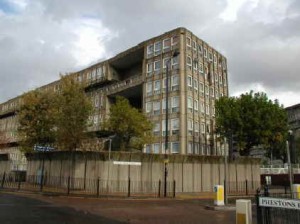My first job in the charity sector was promoting the concept of community foundations – the embodiment of ‘Big Society’ thinking. As a result of the work, Guardian Society chose us as their first ever charity of the month. Here’s the accompanying feature.
From the balcony outside his high rise flat, Nadim looks down at a kid twirling around slowly on a broken roundabout. It has no safety railing and a hole in the middle the size of a child. It’s midday on a Thursday. The child should be in school. Nadim should be in work.
To the left of the flats he can see Canary Wharf and hear the constant sound of new buildings being constructed. To the right the Millennium Dome fills his vision. Yet most people on this sink estate in Poplar are out of work. The inappropriately named Robin Hood estate has one of the highest unemployment rates in the country.
A woman meanders along the path between blocks of flats. Apparently she’s an addict who was evicted from the 8th floor. This floor is known locally as a drug-dealing centre. The woman has now been relegated to the ground floor. Apparently she doesn’t even recognise her own son and daughter after a brain haemorrhage.
In the middle of the blocks is a green hillock – created by shovelling up the rubble left over after building the flats in the 1970s and scattering some grass seed on it. The estate is flanked by a flyover and the Blackwall Tunnel, so this hillock is the only recreation area for the residents. Some of the older ones have never used it as the slope is too steep to be accessible.
But thanks to an ingenious funding application by the Isle of Dogs community foundation, the site will be turned into a “village green”. By securing regeneration money and match funding from the Millennium Greens Trust, the foundation has accumulated £80,000 to redevelop the site. Local children have decided on the theme for the recreation area – dinosaurs and reptiles.
Garden furniture is being designed locally in keeping with the theme. A path leading up to the top will resemble a snake but also make it easier for older and disabled people to access the summit. A safe play area will be incorporated into the landscaping. Children from the local school are going to plant seeds and adults will be trained in horticulture in an attempt by the charity to encourage ownership and prevent future vandalism. Tommy Walsh, star of BBC TV’s Ground Force gardening programme lent his support to the scheme at a photo call with local children.
Although it will improve the environment, the so-called village green isn’t enough. The chair of the community foundation, Chris Mossop, who is also vice-president of a major bank in the area, says: “I’m proud of the contribution which local companies have made but they could do much more.”

Meanwhile, on the money it has raised, the Isle of Dogs community foundation is funding an IT training centre for local residents on the estate.
A new room has just been kitted out in the centre for internet training. The foundation also helps to fund a drop-in play centre so parents can attend college courses or have a break from looking after children. In total the foundation made over £750,000 in grants last year to around 100 diverse local organisations.
Robin Hood Gardens was created by Peter Smithson, an architect as famous in his own time as Norman Foster is today. Despite its many failings, the architecture profession lobbied strenuously for it to be given listed status. In 2009 the government rejected their plea.
Stakeholder Design now has unrivalled expertise in working with local communities to visualise, prototype and improve future spaces before meeting with the architect. Doing so typically saves the commissioning body around 15% of the overall bill as well as delivering much improved community relations.
